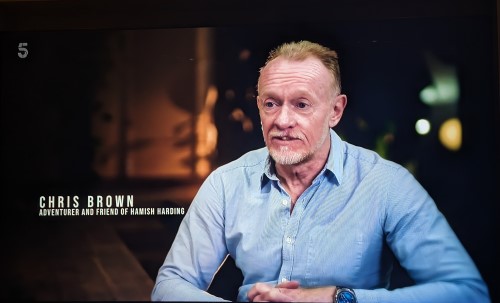Titan Submersible
Sadly, one of my most 'famous' expeditions is one that wasn't a success, wasn't a failure, but simply one that I DIDN'T take part in.
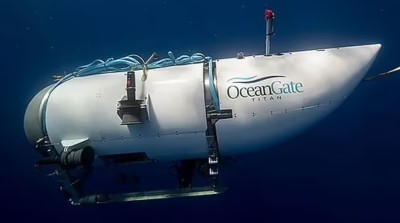
I had been booked on a Titan submersible expedition down to the Titanic wreck at a depth of 3,800m off the coast of Newfoundland. But, due to my own concerns about the safety of the Titan Submersible, I decided against going. It was a decision that possibly saved my life.
During the media frenzy that seemed to follow the story from the minute the Titan Submersible went missing, a lot of inaccuracies were thrown around. In some quarters I was described as a "Billionaire friend" (I'm definitely not!), that I was on board the support vessel (I wasn't), that I'd refused to board the Titan on the morning of the dive (I wasn't there), that I'd been due on the same dive as Hamish (it never got that far) and that Hamish and I were best friends (we were acquaintances) and undertaken many expeditions together (one).
Here's the true story…
Beginnings of the Titan Expedition
My potential dive down to the Titanic began on a trip to Necker Island in the British Virgin Islands. You will see elsewhere on this site that I am signed up to go on a Virgin Galactic flight up into Space. Twice a year, Galactic "Future Astronauts" are invited to visit the island, and I've been an eager participant in those trips for a few years.
On one of those trips, in November 2016, the subject of the Titanic came up during a discussion in one of the beachside bars – yes, life is hard! One of the guys I was with comes from a family with a big maritime company and another had been fascinated by the Titanic since he was a young boy. This second guy had contacts who said they were putting together an exploratory trip down to the Titanic on a new low-cost sub that they were in the process of developing, and that they were looking for 'paying' mission specialists to go on the dives.
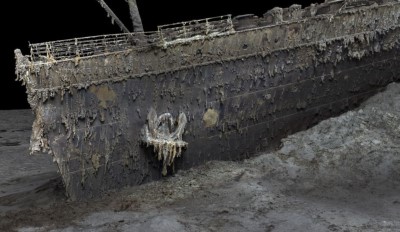
As tends to happen in bars, we agreed it sounded like cool thing to do and that we'd sign up. What's different on Necker, as opposed to the many agreements to do marathons, triathlons or climb mountains that are brokered in bars up and down the country, is that these trips actually tend to happen. All of the men and women on the Galactic programme are self-starting, successful individuals and are 'doers' rather than just talkers.
Within two weeks of leaving Necker, we had the details of the company,Oceangate, the submersible, then called Cyclops 2, and an outline contract.
Signing up with Oceangate
The deal was to take part in a dive to the Titanic in June 2018 as a Mission Specialist. Such specialists would be fee-paying passengers who accompany scientists down to the Titanic, but who also had to be trained to support the scientists and to operate some of the functions of the sub, such as ship-to-surface communications. As such, Mission Specialists were considered part of the greater expedition team, not as tourists.
The dives were being undertaken to make a 3D scan of the wreck. By comparing that scan with one to be taken in the future, the idea was that it might be possible to determine which parts of the Titanic were prone to decay and steps might then be possible to help preserve the wreck. A side function of the dives was to catalogue the sea-life in the vicinity of the wreck.
An initial deposit was to be paid, with two more payments due when certain 'milestones' were made during the development of the submersible. The main triggers of the milestone payments were based around depths that the Cyclops had achieved, specifically the depth of 4,000 metres, which was expected in October 2017.
Cyclops 2, which was to become known as The Titan Submersible, was described as "a 5-person submersible capable of taking up to 5 crew and mission specialists to depths of 4000 meters."
I signed and returned the contract on 21st November, 20176.
Knowing Hamish Harding
The Virgin Galactic programme is obviously well-known in 'space' circles. So, when the organisers of a trip for Buzz Aldrin, the second man ever to walk on the moon, to the regular South Pole had two spare places, they naturally turned to the Future Astronauts. Without hesitation I put my had up for the expedition. Read on another page about my long-standing interest in space dating back to watching the moon landings with my late father.
It was on this trip that I first met Hamish Harding.
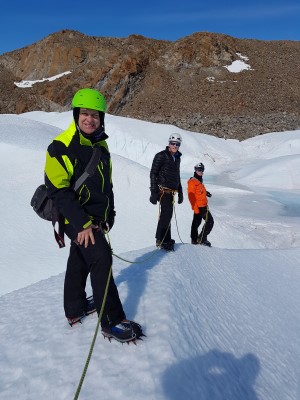
In the days before we flew to Antarctica, we had a few days in Cape Town. As a group we decided to go up Table Top Mountain, like just about everybody else who ever visits Cape Town.
However, whilst the group wanted to go up in the cable car, I decided that I'd like to hike and climb to the top, despite the heat, humidity and warnings about being mugged or attacked on the way up. The only other person in the group who was up for the more difficult way up was Hamish.

And so, it was on that climb that I got to know Hamish and realised what a genuinely nice guy he was. His love of aircraft was obvious, but we also shared a joy for modern-day adventuring and exploring.
My Titan Safety Concerns
My concerns over the safety of the Titan Submersible started more as a frustration with the lack of progress.
My dive was due to take place in June 2018 and Oceangate promised to let us know by the end of October 2017 if the dive wasn't going to take place. However, by the end of October, Oceangate were haling a 'major milestone' as being the arrival of the pressure at their facilities. Yet they did not formerly cancel or postpone the 2018 dive.
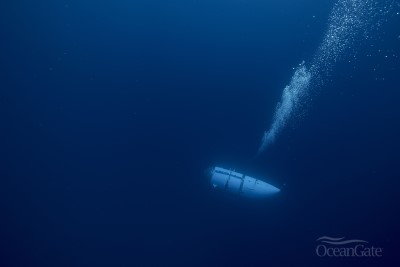
They were now sticking to a 'new' schedule which had a dive to 300m (1,000ft) in February 2018, followed by 4,000m in April out in the Bahamas (to "validate the pressure hull") and the operational dive in June.
This unachievable schedule would eventually lead to me missing the opportunity to summit Mount Everest.
In January 2018, we received an updated agreement in which Oceangate said, "we are requesting final payment on February 1, 2018 but that it is fully refundable in the unlikely event that Cyclops 2 is not certified this year to reach the Titanic." Furthermore, Oceangate stated "we mobilize to the Bahamas for deep sea testing where we will certify the sub to a depth of 4,000 meters. The deep dive tests will be observed by a representative of DNV/GL, who will independently certify the sub's performance."
Of course, the Titan Sub, still being called Cyclops 2, did not achieve the depths by February and the June dives were pushed to 2019.
By October 2018 the Titan craft had reached 4,000m but only as an unmanned vehicle. Nevertheless, Stockton Rush and Co decamped to the Bahamas where he successfully piloted the submersible down to 504m. Hmmm, I think everyone would agree that's not exactly close to 4,000m.
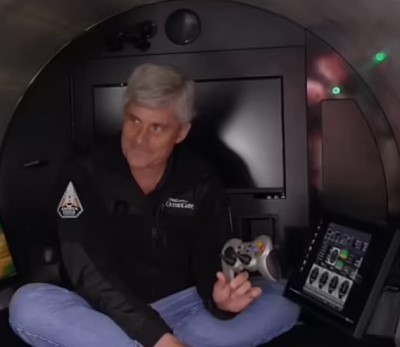
Stockton Rush with Titan Controller
sitting inside the Titan
During the test in the Bahamas and on video calls/updates, the slipshod approach to getting the Titan ready to dive became apparent.
- They were using building pipes for ballast.
- The main controller for the craft was a video game controller – which Oceangate seemed to think was cool or 'bragging' point about how innovative they were being. It wasn't even the best controller made that that particular company.
- The system ran on Bluetooth and internal Wi-Fi, not hard wiring. So, if any of the signals dropped, the whole operation of the craft would be stuffed.
- The internal lighting of Titan was obviously procured at some sort of DIY warehouse.
- The external thrusters, just three of them, had external wiring which looked all over the palce. I'm no expert on such matters but I'd have thought internal routing would be better when you are diving to a wreck with many opportunities to become snagged.
- The satellite beacon, used to transmit Titan's position upon surfacing, was attached by zip ties.
- The crew of the Titan were being made to sit on the floor – flammable material and no seats – so it could fit as many people as possible into such a small craft.
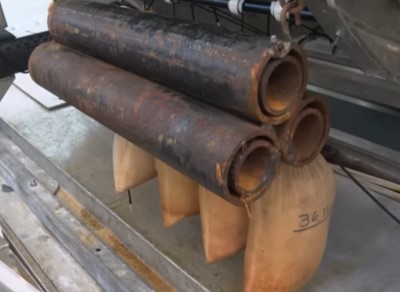
Building pipes used as Titan Ballast
During the testing in the Bahamas the Titan was hit by lightning. Things like that happen at sea. All of the electrics blew. That then caused the end of the testing. Not only did the Titan not have a backup system, there wasn't even a backup system on the support vessels. Normally, you would expect full redundancy of essential systems both onboard the submersible and also onboard the support vessel (which would also have a backup system).
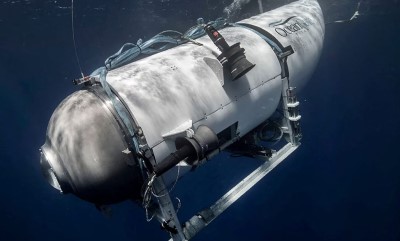
Snagging hazards on Titan
It was blatantly obvious that corners were being cut to keep costs to a minimum.Little did any of us know that at the time Oceangate's own engineers were warning of dangers. And the rest of the 'submarine community' were begging him to stop what he was doing. Apparently very visible signs of delamination and porosity had been seen in the body material.
Withdrawing from the Titan programme
In truth, I hadn't liked what I'd seen from the programme through to November 2018. Then came the clincher.
Stockton Rush announced that he would no longer attempt to have the Titan Submersible classed by a marine-certification agency such as DNV (see above) He had no interest in using an external evaluator who would, as he declared, "first need to be educated before being qualified to 'validate' any innovations."
That was more than enough for me.
On 27th November, I sent the email, which possibly saved my life, requesting a refund and withdrawing from the Titan programme.
Rather ominously, I wrote, "Yep, being crushed by 5800psi isn't my idea of fun"
The Titan Disaster
On 18th June 2023 I heard that a submarine destined for the Titanic had gone missing. Something inside made me fear the worst. After all, not many vessels carrying 'tourists' attempt to reach the Titanic.
My fears proved well-founded. It was the Titan from Oceangate. And a text to Linda, Hamish's wife, confirmed the worst; he was onboard the missing submersible.
At first everyone thought the Titan had just lost communication with the surface. Perhaps it had surfaced but couldn't communicate with the support vessel (mothership). Perhaps it was snagged on the wreck. Or perhaps it had simply lost power and sunk to the bottom of the ocean.
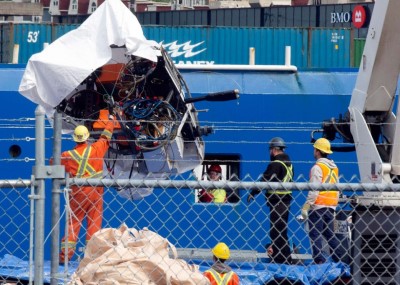
Wreckage from Titan
being offloaded by the US coastguard
A fully fledged rescue operation swung into operation with the five people on board, including Hamish, only having 72 hours' worth of oxygen available. Even if the Titan was on the surface, the hatch was only capable of being opened from outside.
There was one moment of hope, part way through the operation, when knocking sounds were picked up by sonar beacons. Perhaps the trapped crew were tapping the hull in the hope of alerting rescuers to their location.
It was during this rescue operation that I appeared in media around the world as the guy who didn't go on the doomed Titan.
Interview with CNN during the search for Titan
Sadly, as we all now know, the Titan had actually imploded on its initial dive. The US Navy had picked up sounds consistent with a submersible imploding not long after the dive had commenced. All on board had perished. Initial assessment of the wreckage points to a failure of the carbon fibre hull.
Where did Titan Implode
The wreck is approximately 690 km in a south south-east direction from the coast of Newfoundland in Canada at coordinates 41º43'32"N, 49º56'49"W. It lies at a depth of around 3,800m where the pressure would be around 5,800psi.
The Titanic wreck is in two main parts, approximately 600m apart. Titan debris was found about 500m from the bow of the Titanic.

